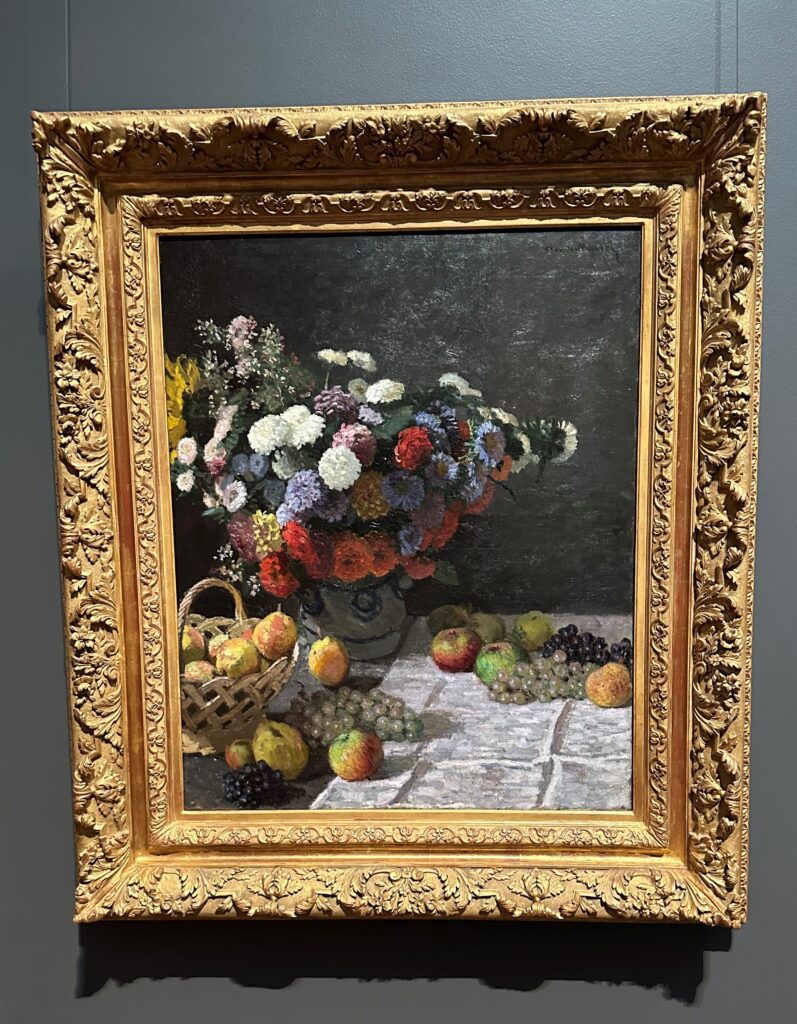World-famous artist Claude Monet worked on a painting for years, and then in a fit of frustration, he would take a knife to his creation and tear it apart. “My life has been nothing but a failure, and all that’s left for me to do is to destroy my paintings before I disappear,” he once said.
Claude Monet is described as the father of Impressionism. Not because he was a great impressionistic painter, but because he invented the method. The term came from the title of one of his paintings, Impression Sunrise, or, “Impression, soleil levant (sunrise).”
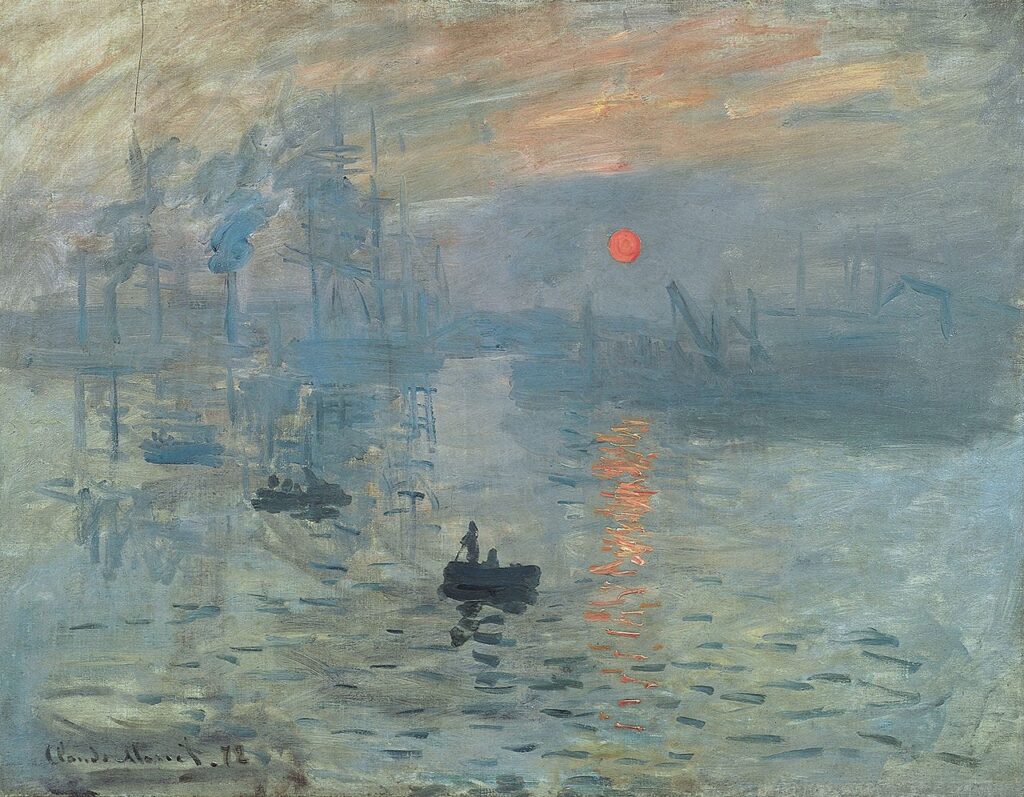
Claude Monet Impressionism Paintings
You know you’re good at your job when an entire artistic movement is described by a word you once used to name your painting.
But the origin of the Impressionism phrase came not from admiration but a critical attack. Monet’s “Impression” painting received this scathing and sarcastic review from art critic Louis Leroy in the French newspaper Le Charivari –
“Impression – I was certain of it. I was just telling myself that, since I was impressed, there had to be some impression in it… and what freedom, what ease of workmanship! Wallpaper in its embryonic state is more finished than that seascape.”
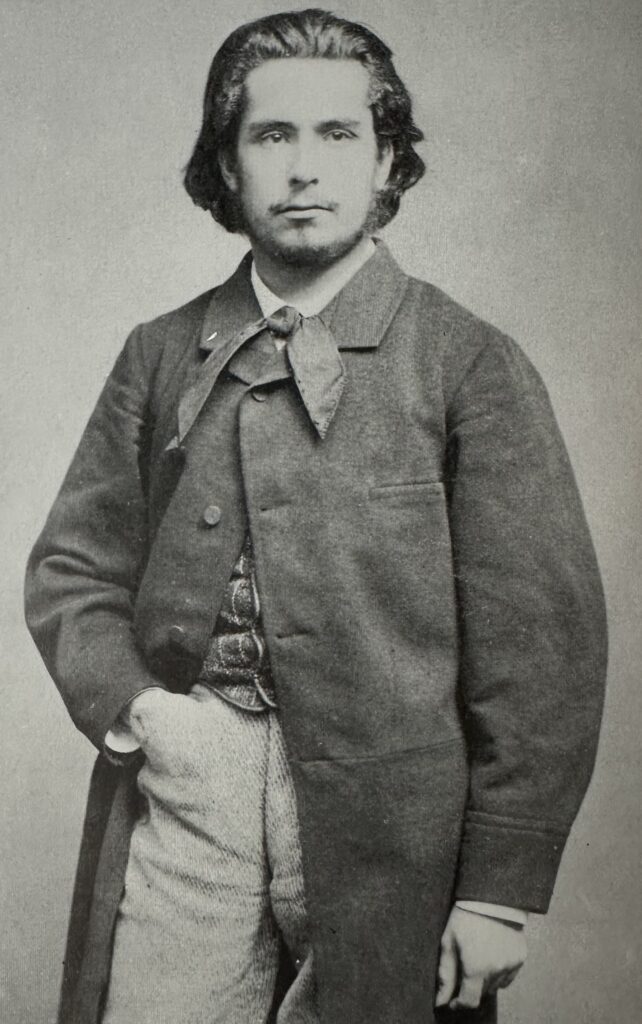
While Leroy’s goal was to dismiss Monet’s painting which was so different at the time, and in his opinion, “wallpaper in its embryonic state,” he actually helped launch Monet’s popularity.
The term “Impressionism” grew from that critical review and started to gain interest and acceptance. Leroy’s takedown of the emerging impressionistic art form backfired.
Monet was now at the leading edge of this movement, obsessed with a new way to display light and color on a subject. His obsession only grew by the day.
Captivated by Light
He was driven to study the science of light. Amazed at how fast brush strokes could influence perception. Often, he would paint the same landscapes at different times of the day to grasp how light was hitting objects at different angles.
Monet wanted to capture the “instantaneity” of light on the canvas; his terror was that he wouldn’t be able to achieve his mission.
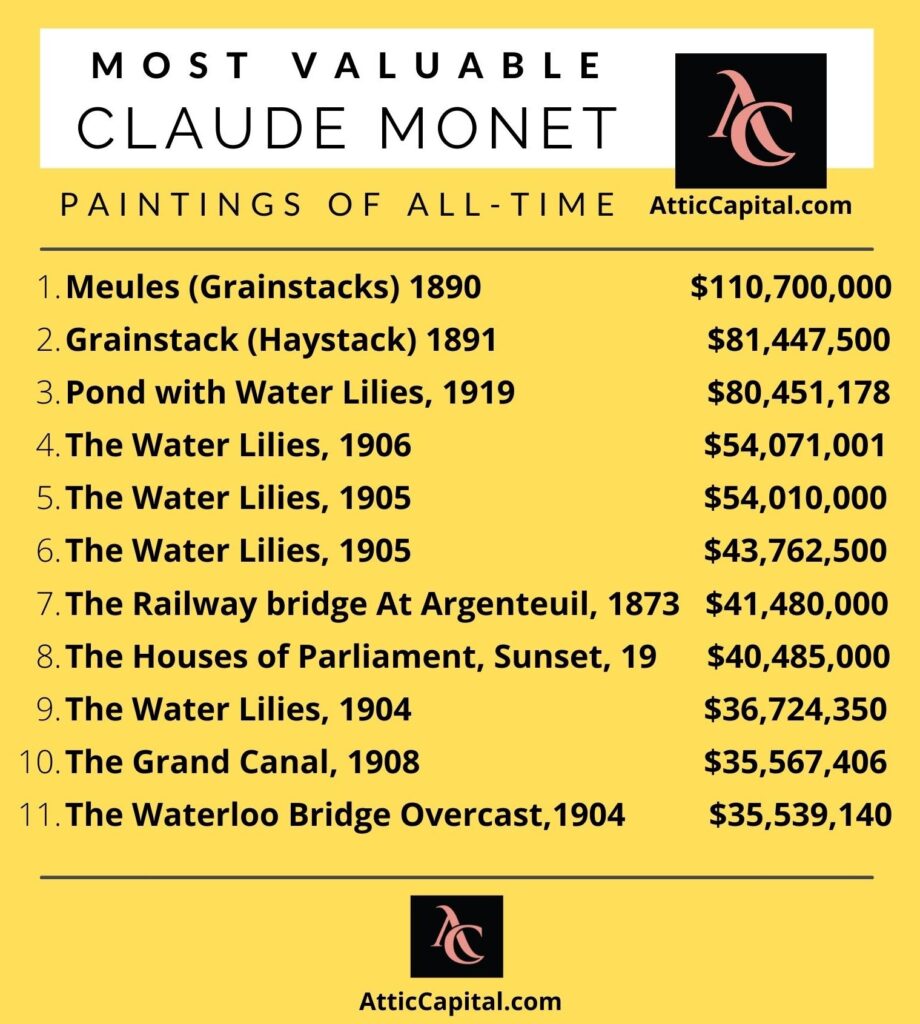
“To paint the sea really well, you need to look at it every hour of every day in the same place,” he wrote in a letter to his wife in 1886.
At times Monet would set up several easels at the same time and race back and forth between them, chasing the moving light.
Mesmerized by Color
Monet was simultaneously chasing light and wrestling with color. He would write, “color is my day-long obsession, joy and torment.”
He was quoted, “I haven’t yet managed to capture the color of this landscape; there are moments when I’m appalled at the colors I’m having to use, I’m afraid what I’m doing is just dreadful and yet I really am understating it; the light is simply terrifying.”
Obsessed with Color
His obsession to master color is best described in his own words when he admitted, “Colors pursue me like a constant worry. They even worry me in my sleep.”
He didn’t need satirical articles about his work published in newspapers to drive him.

Now hanging at Kunsthaus Zurich
Monet was his own harshest critic. His quest for perfection drove him to destroy his own creations.
In 1908, a show featuring his work in Paris was postponed after he attacked his paintings with a knife, slashing 15 water lily canvases.
Ross King, author of Mad Enchantment, wrote, “He would rip them to shreds or even put his foot through them if he was unhappy with his work. He once threw his easel and paintbox into the river in a fit of temper.”
Attempting the Unimaginable
Monet would destroy over 500 of his own paintings in fits of rage, frustration, torment, and despair. But the more you learn about the man, the more you begin to understand his actions as almost completely justified. Almost sensible.
He was attempting the unimaginable, nearly every minute of every day of his life. It’s hard to imagine anyone would behave any differently. As you learn more about Monet, it’s a wonder he allowed any of his works to survive.
Pursuing the Impossible
Understanding Monet’s mindset clearly defines why he’s the Father of Impressionism and why his masterworks are some of the most valuable paintings ever created in human history.
Monet went beyond light and color. The more famous he became, the more determined he was to “render instantaneity.” That is, depict the atmosphere between painter and a subject.
He called this layer the “l’envelope,” or the air itself—particles of soot, dust, light, and the perception of it.
While working on his series of 25 works titled ‘Haystacks,’ he explained his plight. “To me, the motif itself is an insignificant factor; what I want to reproduce is what lies between the motif and me… I am pursuing the impossible.”

Claude Monet’s Most Famous Paintings
Before we look at Monet’s most famous paintings, we need to understand a little about his early history.
Claude Monet’s famous paintings are not just incredible works of art but also some of the most valuable paintings in the world. What makes Claude Monet’s paintings so great? And why are they so valuable?
Claude Monet was a French artist and key figure of the Impressionist movement. His art style depicts realistic outdoor scenes with thin brush strokes, accentuating different lights.
Monet’s Art Style
Monet’s paintings concern the passage of time and ultimately include movement as an element of perception and experience.
The French art community initially criticized impressionism before being adopted into mainstream culture.

Now hanging at Musee d’Orsay, Paris
Monet’s Early History in Normandy
Oscar-Claude Monet was born in 1840 in Paris. In 1845, his family moved to Le Havre, Normandy. Monet met a fellow artist, Eugene Boudin, on the Normandy coast – one of the first French landscape painters.
Boudin became his mentor and taught the young Monet to en Plein air painting.
This painting style takes place outdoors and studies how natural light impacts subject matter rather than having a forced perspective of an artificial environment within a painting studio.
The Formative Years in Paris
Monet continued his studies in Paris at the Académie Suisse, a smaller and more informal academy than the famous Académie des Beaux-Arts.
It was here that Monet met and befriended Armand Guillaumin, Camille Pissarro, Edouard Manet – friends that would later become notable figures in the Impressionist movement.
Seascapes and Portraits
In 1861, Monet served in the Algerian calvary for two years before contracting Typhoid, forcing him to return home.
Back at Paris, he met Pierre-Auguste Renoir, Frederic Bazille, and Alfred Sisley, where they would paint various seascapes and portraits along the mouth of the River Seine.

In the early years of his life, Monet was focused on getting his projects in The Salon, a prestigious art exhibition at Académie des Beaux-Arts. His initial works would not be accepted, other than two pieces he painted in 1866 and 1868.
Americans would get a taste of the up-and-coming artist in 1866, when his works appeared in the Derby Gallery exhibition in New York City.
Developing His Original Style
Slowly over the next decade, the east coast of the U.S. was noticing Monet’s original and fresh style in his landscapes.
Not only were Monet’s paintings appearing in New York exhibits, but American painters were traveling to Paris with an interest in the new French Impressionist artists.
They returned to New York envigorated after witnessing the energized Paris art scene. Talk of Monet was at the center of it all.
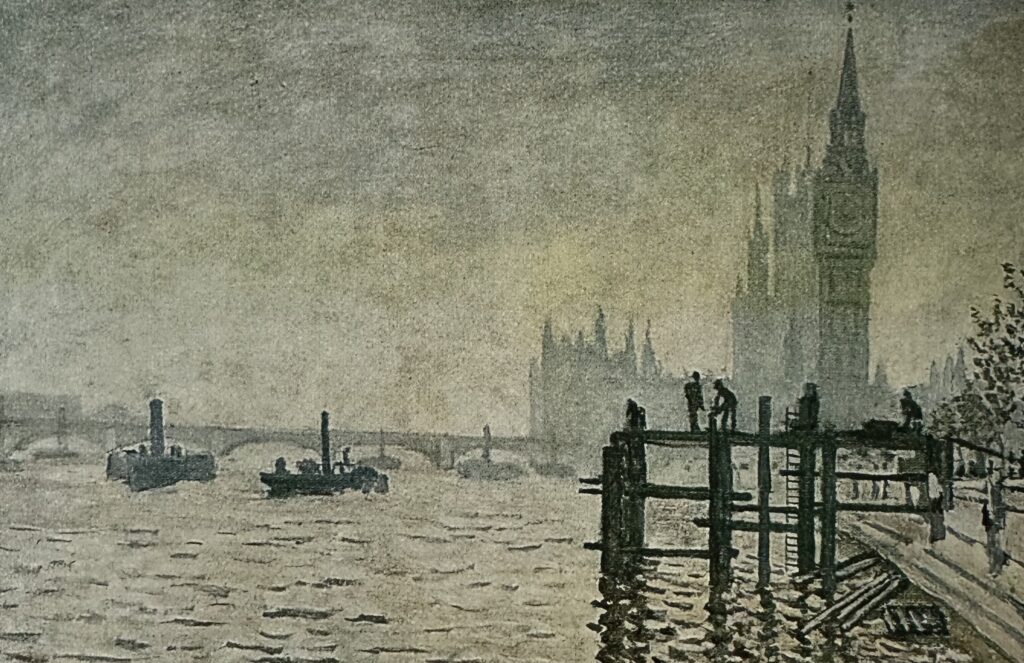
Now hanging at the National Gallery, London
Claude Monet Famous Paintings
The Woman in the Green Dress was the piece accepted in The Paris Salon in 1868.
Although Monet considered the Paris Salon anti-progressive and stuffy, he caught the attention of the government-sponsored exhibition.
This painting is notable because it is a portrait of his future wife Camille Doncieux and that it was a study in Realism, compared to the Impressionist style Monet’s work is known for.
He would feature her in other paintings, such as The Woman in the Garden.
Claude Monet Most Expensive Paintings
- Meules (Grainstacks) 1890 Sold in 2019 for $110,700,000
- Grainstack (Haystack) 1891 Sold in 2016 for $81,447,500
- Pond with Water Lilies, 1919 Sold in 2008 for $80,451,178
- The Water Lilies, 1906 Sold in 2014 for $54,071,001
- The Water Lilies, 1905 Sold in 2015 for $54,010,000
- The Water Lilies, 1905 Sold in 2012 for $43,762,500
- The Railway bridge At Argenteuil, 1873 Sold in 2008 for $41,480,000
- The Houses of Parliment, Sunset, 1900 Sold in 2015 for $40,485,000
- The Water Lilies, 1904 Sold in 2007 for $36,724,350
- The Grand Canal, 1908 Sold in 2015 for $35,567,406
- The Waterloo Bridge Overcast Weather, 1904 Sold in 2007 for $35,539,140
In 1868, Doncieux became pregnant with their first child Jean, and they married in 1870, just before the outbreak of the Franco-Prussian War.
In 1869, Monet and Renoir, both poor, visited La Grenouillère – a bathhouse on the River Seine.
Developing His Eye for Color
They painted en Plein air and captured the scenes of boats, swimmers, and people along the river in the summer weather.
The time they spent together that summer shows how they started developing the early inklings of the Impressionist style.

The Franco-Prussian War and Argenteuil
During the Franco-Prussian war in 1870, Monet and his family moved to London to avoid conscription.
The terrible weather and altering conditions obstructed Monet’s ability to paint. However, he loved the city and would later come back to London in 1899 to produce the Houses of Parliament series.
From Monet’s viewpoint, this work features the Palace of Westminster at St Thomas’ Hospital overlooking the Thames River.
Different Sky and Weather
The landscape painting is painted at different times of the day under different sky and weather conditions depicting the same scene.
The English landscape provided Monet and Pissaro (who also moved to London during the war) inspiration for their future work.
Study of famous landscapists John Constable and Joseph Mallord William Turner in several London museums were influential in their study of light and color.
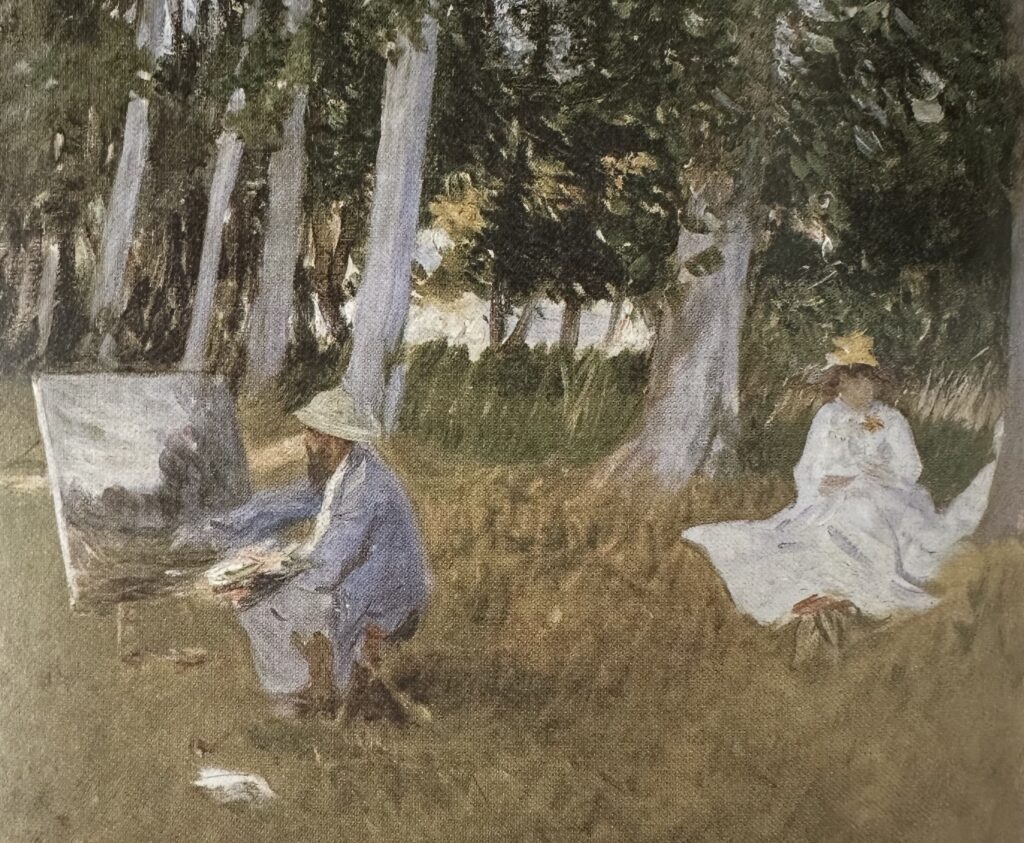
Now hanging at the Tate in London
Back to France
In 1871, he moved back to France in Argenteuil, where the French countryside would be a source of inspiration for the Impressionists.
The Bridge at Argenteuil (1874) exemplifies life at Argenteuil, from the sailboats that would go down the Seine to its rural beauty and urban life.
Monet bought an old small fishing boat with a floating studio, enabling him to paint nature views from the River Seine in otherwise inaccessible places.
Camille Monet on a Garden Bench (1873) depicts Madame Monet after her father passed away. She holds a letter that displays the message in her hand, while the man to the right is interpreted to be the messenger of death.
The piece plays on this idea of life and death, the bright field to the left with the darker muted tones on the right.
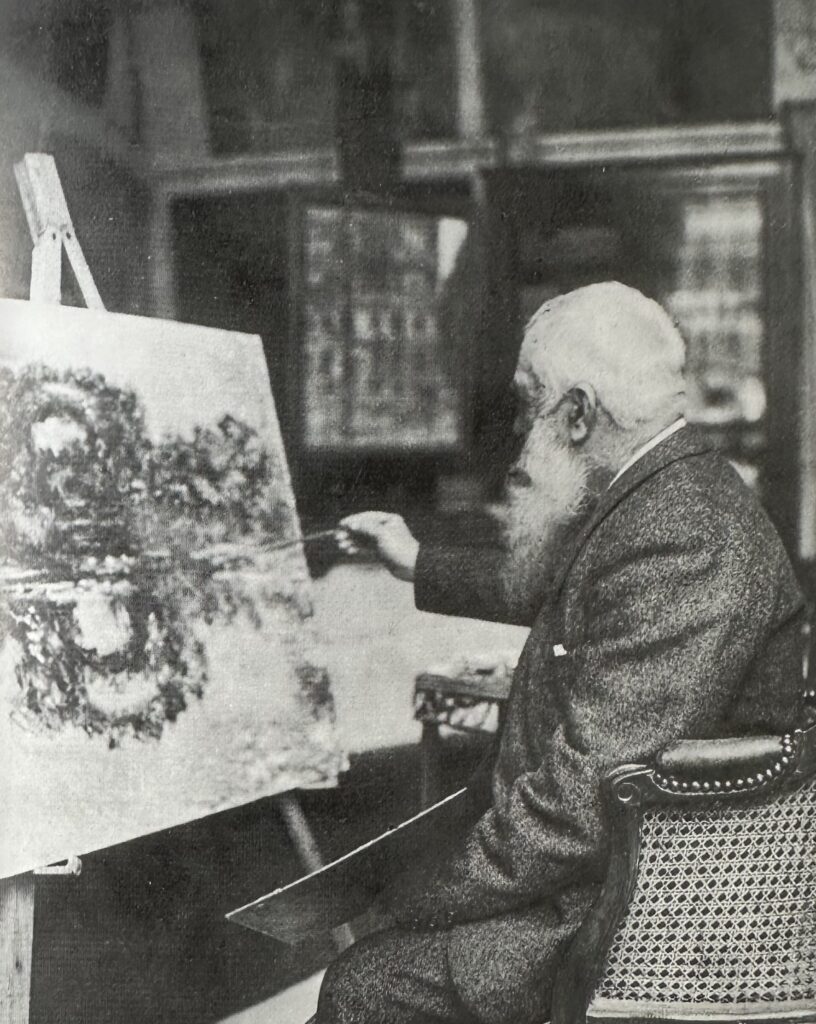
Some of Monet’s paintings include human figures and the lighter, more playful times with his family.
Woman with a Parasol (1875) features Camille and their son Jean strolling through Argenteuil on a windy summer’s day.
While his beloved family is the primary subject of the painting, it exemplifies Monet’s ability to capture light and movement using clever shading and brush strokes.
Claude Monet, The Father of Impressionism
Monet and his contemporaries continued to paint in their unique style that combined en Plein air painting with short, light brushstrokes and contrasting shades throughout their careers.
The Impressionists rejected the prevailing academicism that persisted in the art community and held their first independent exhibit in 1874.
Monet displayed his now famous works, including Impression, Sunrise (1872) of the River Seine in Le Havre.

Monet depicts a hazy mist over the French harbor. While the painting gave the Impressionists their name, it is atypical of Monet’s Impressionist paintings.
The brush strokes are not as refined and short, and the colors are muted, almost restrained.
The work took a minimalist approach of Impressionism, applying a few brushstrokes to suggest the dockyards in the background and the boats in the foreground.
Boulevard des Capucines
Boulevard des Capucines (1873) is another now-famous Monet painting that captures the busy Parisian life during the winter.
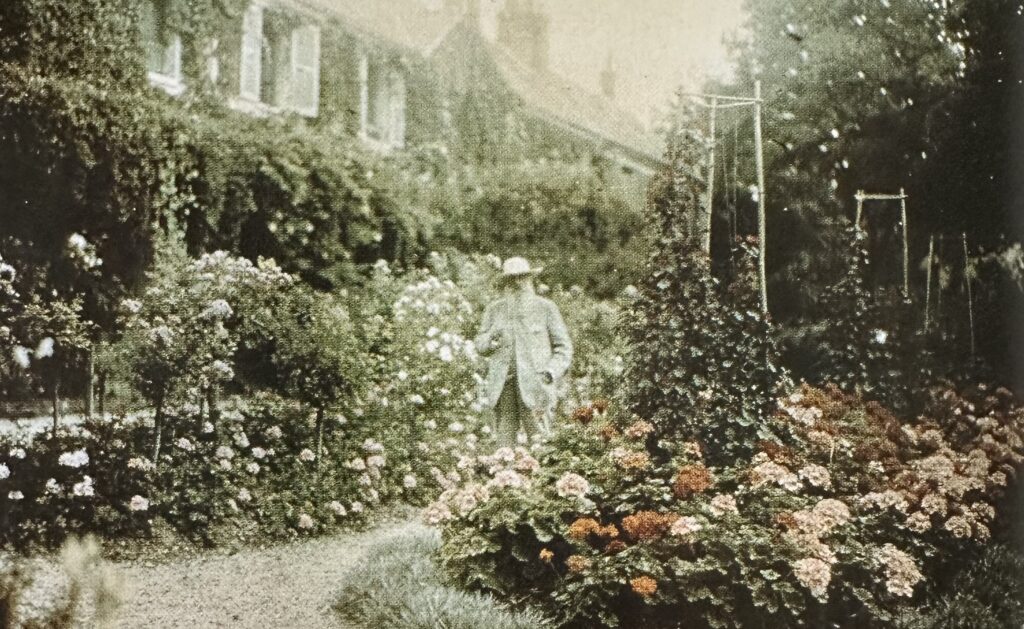
The use of short, quick brushstrokes creates the impression of people alive with movement without applying a lot of detail.
The exhibition was a failure, and art critics were remarkably hostile toward the fledging group. While around 3,500 people visited the exhibit, most attended to criticize the works on display.
The Art Critic’s Review
Art critic Louis Leroy coined the term “Impressionism” from the title of the now-famous Le Havre painting as a disparagement. In his scathing review, he wrote:
“Impression, I was certain of it. I was just telling myself that, since I was impressed, there had to be some impression in it — and what freedom, what ease of workmanship! A preliminary drawing for a wallpaper pattern is more finished than this seascape.”
While the first exhibition was a commercial flop, the Impressionists would not give up here. They held seven more exhibitions in the following years until the final Impressionist exhibition in 1886.
These early oil paints would inspire others to move to Argenteuil to study Impressionism.

The Death of Camille
In 1876, Ernst Hoschede, a wealthy department store owner and art collector, commissioned Monet to paint decorative panels and other paintings.
This same year, Camille became ill with what is speculated to have been metastatic cervical cancer.
The birth of their second son Michel in 1878 further deteriorated her health with medical complications.
Together, the Monets and the Hoschede family, which included Alice Hoscede and their six children, moved to the village of Vetheuil in the autumn of 1878.
Camille would officially be diagnosed with cancer in 1878 and died at the age of 32 in 1879. Monet made a study of oil paintings of his late wife, notably Camille Monet On Her Deathbed (1879).
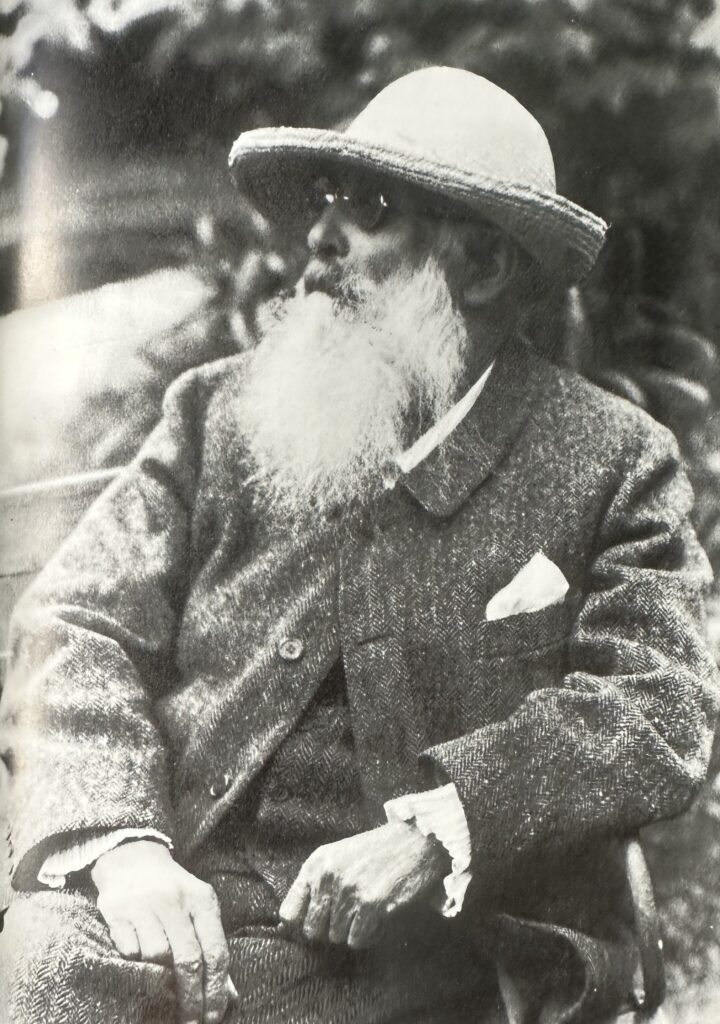
Now hanging at The Museum of Modern Art, New York City.
The work is highly expressive with white, gray, and purplish colors that intermingle with her body. It’s impossible to imagine the sorrow and loss Monet must have felt looking at his wife’s dead face while painting her.
Continuing On
Following Camille’s death, Monet continued to study the Seine. Still, he began to abandon Impressionists techniques around this time, favoring darker tones and displaying landscapes he once painted in vivid colors such as the Seine in harsh weather.
He would continue to live with Alice Hoschede and their combined families.
Alice
While the Hoschede family lived with the Monets in Vetheuil, Ernest Hoschede spent increasing time in Paris for work, and Monet began to develop a close relationship with Alice.
When Camille died in 1879, Monet became the head of a household that included his two sons and the Hoschede family.
Ernest refused to pay for Alice and their children’s upkeep during this time, putting a tremendous financial strain on Monet.

He would travel across Europe from Italy to the Netherlands to paint landscapes that would be commercially successful. The families moved to Poissy in 1881 before moving to Giverny, France, in 1883.
In the spring of 1886, Ernest demanded that they move to Paris with him, but Alice and the children remained with Monet.
Despite their relationship, Alice would not marry Monet until one year after Ernest Hoschede’s death in 1891.
Giverny
In 1883, Monet and his family rented a house and garden in Giverny with a barn that doubled as a painting studio and orchards with various fruit trees.
The family worked and built up the gardens, which served as Monet’s source of inspiration for the next 40 years.
Monet would eventually purchase the house in 1890 and grow his garden.

Garden Path at Giverny (1902) shows how elaborate his garden became, importing flowers from various sources to produce beautiful mixtures of colors.
Monet’s garden included two sections, the flower garden called Clos Normand and the water garden, which included the famous Japanese bridge covered in wisterias.
He hired two full-time gardeners, which would later grow to six to tend to his flower collection featured in his work.
Experimenting With Different Conditions
Monet began to work on paintings that depicted a single subject under different weather and light conditions.
The Haystacks series (1890 – 1891) exhibited twenty-five paintings of haystacks from other points of view under different times of day across multiple seasons in many types of weather.

At first glance, it seems dull and unimaginative to paint… well, stacks of hay.
However, the series is one of Monet’s most notable artworks because of his ability to capture the nuances and the variation of the vibrancy of the haystacks with the change in lighting from the sun.
Rouen Cathedral, 1894
Monet’s cathedral series focused on the Rouen Cathedral. The works were a series of over thirty paintings from 1892 to 1893.
This was during a time of renewed interest in Catholicism throughout France. Monet managed to reflect changes of the Rouen Cathedral under various lighting conditions and at different times of the year.
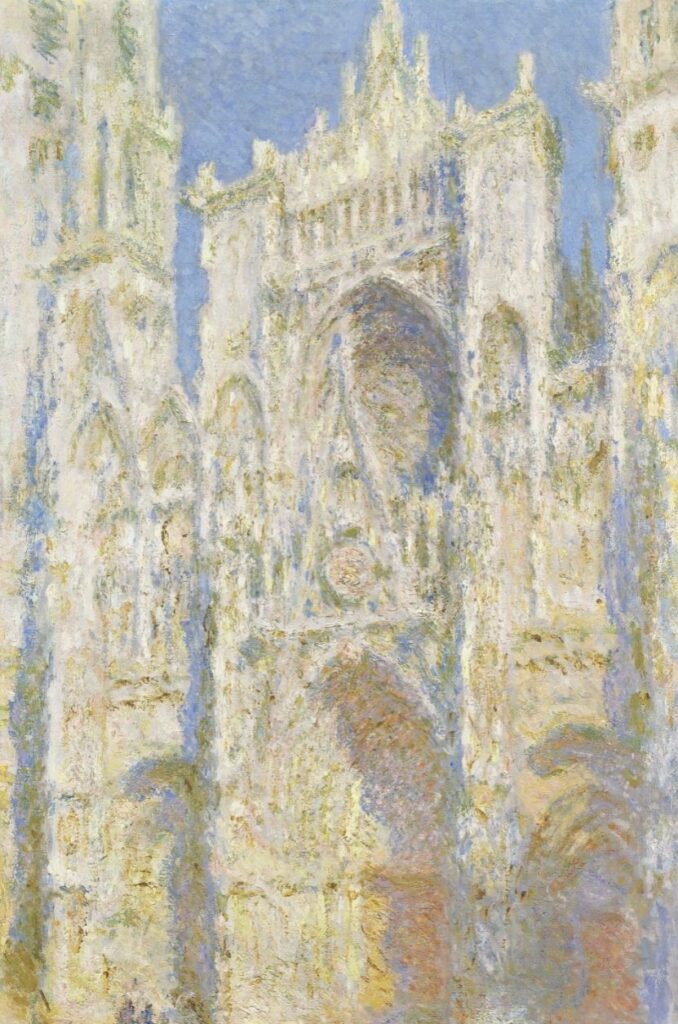
In 1893, Monet purchased land with a pond near his property that eventually became a water lily pond. From 1897 to the end of his life in 1926, he devoted himself to the Water Lilies paintings.
The Water Lilies were a series of paintings including over 250 different perspectives of water lilies.
Bridge Over Water Lilies
The Bridge over a Pond of Water Lilies (1899) depicts the Japanese wooden bridge spanning the water lily pond, surrounded by luscious green vegetation. Monet’s garden would be the source of his paintings for the later years of his life.
Other than a sole visit to Venice in 1908 where he painted over 30 landscapes, including ‘San Giorgio Maggiore at Dusk,’ Monet focused on the hundreds of water lily paintings.
Now, several of his water lily paintings can be seen hanging in The National Gallery in London.
He is a featured artist at the greatest museums in the world, including the Musee d’orsay, the National Museum, the Metropolitan Museum of Art, and even has his own museum in Paris, the Musee Marmottan Monet.

Monet Most Famous Paintings Later in Life
The later years for Monet were filled with sadness and hardships. Alice died in 1911, and his oldest (and favorite) son Jean died in 1914. Their deaths put Monet into a depressive state.
Following the death of Alice, he increases the scale of the water lily paintings, where most measure around six square feet.
Additionally, he changed the color palette to use bright spots of color that suggested flowers in the lily pond.
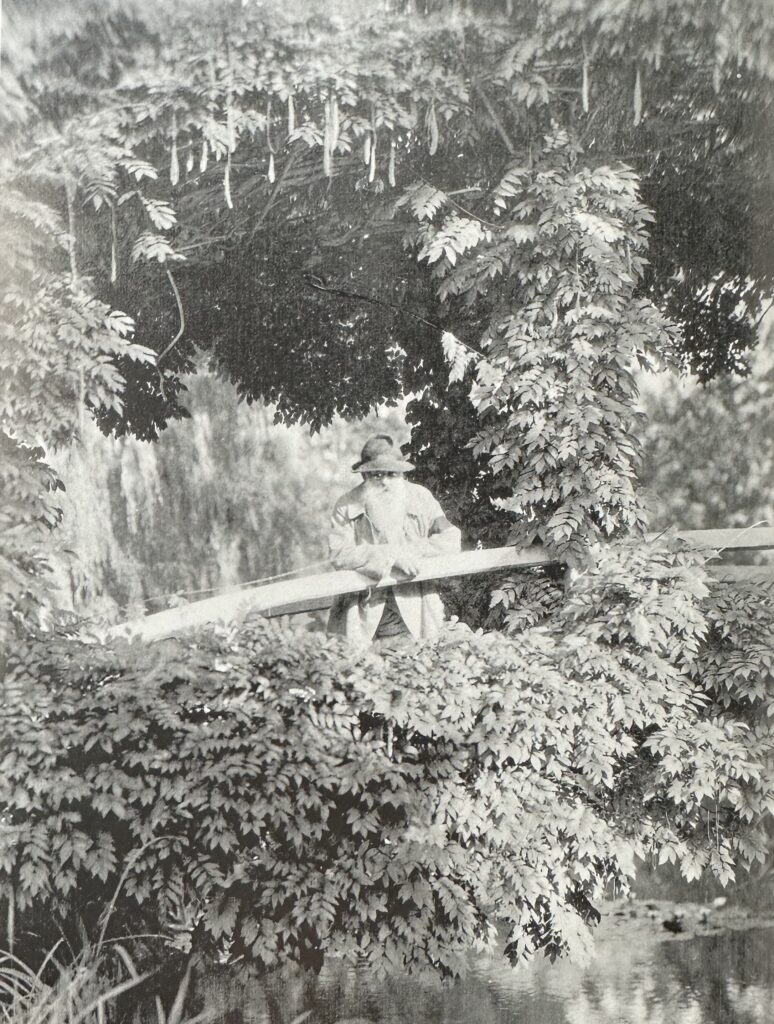
From the archives of the Musee Clemenceau in Paris
Around 1912, Monet began to develop signs of cataracts. While several ophthalmologists suggested that he get surgery, Monet was resistant to the idea because he was worried his vision would be permanently damaged.
Water Lilies, Japanese Bridge
In the following years, his eyesight deteriorated, which altered his perception of color.
This is highlighted in a piece like Monet’s Water Lilies, Japanese Bridge (1923) which shows a mixture of fiery reds, orange, and yellow.
Other pieces of work that he made in this period were darker, muddled, and muted, lacking the vibrancy of his earlier work. He pained ten Weeping Willow (1918-1919) paintings in response to those who died in World War I.
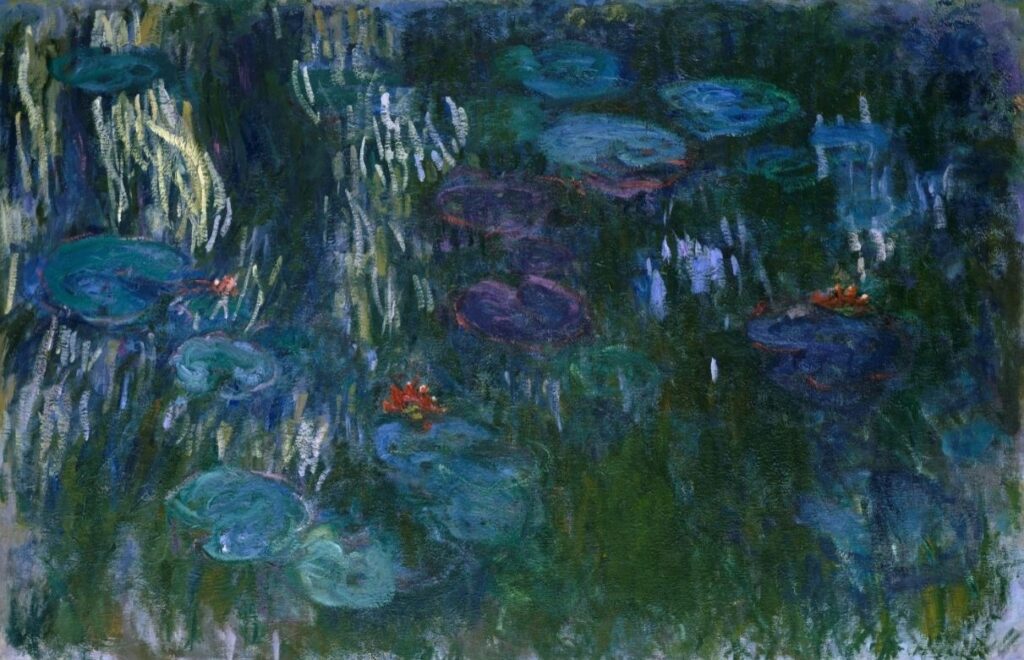
While these paintings are dark, brooding, and shadowy, capturing the grieving mood of the time, his failing eyesight impacted his choices for the series.
Monet eventually agreed to cataract surgery in 1923, and while he had some post-operative complications, his vision improved considerably by 1925.
By the end of his life, his paintings became more abstract with broad brush strokes, surprising harmonies or clashes of colors, and minimal details that diverged from his earlier works.
“Unfinished”
He created monumental work that spans over 14 feet wide as panoramas. The Musee de l’orangerie in Paris includes eight large murals of his water lilies series, the Nympheas. Monet died of lung cancer in 1926 at the age of 86, leaving the Water Lilies “unfinished.”
The prolific list of Claude Monet famous paintings includes some of the most recognizable artwork in the world.
However, as one of the pioneers of Impressionism and Abstraction, he left a vast body of work that serves as the foundation for modern art, paving the way for modalities like Expressionism, Fauvism, and Abstract Expressionism.
